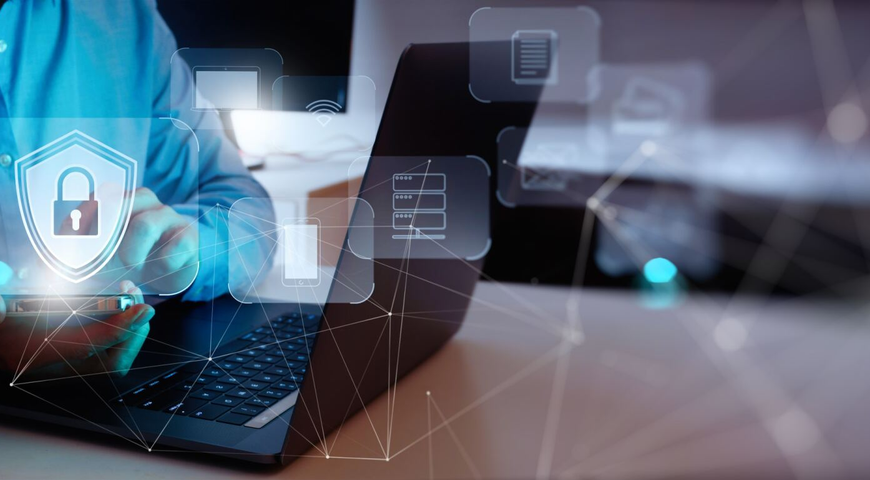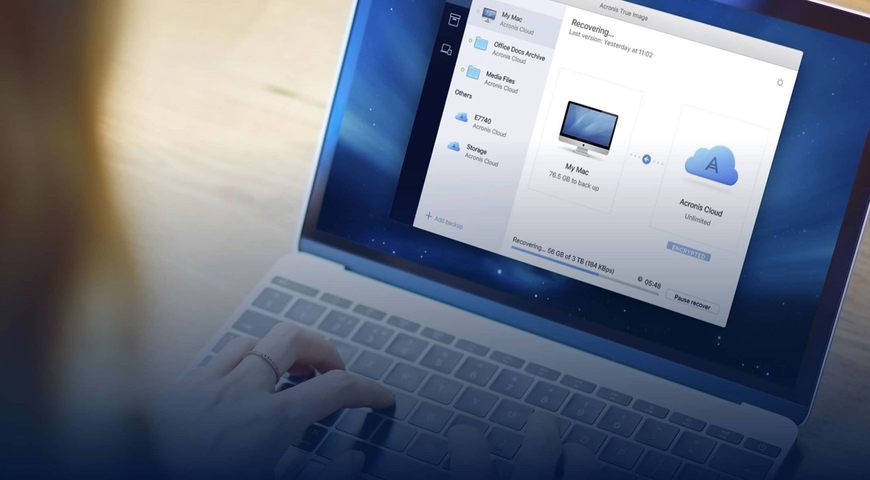
Endpoint security (or "endpoint protection") focuses on securing endpoints — laptops, desktops, mobile devices, etc. — from potential cyberthreats. Cybercriminals can target a weak entry point and infiltrate an organization's network, so endpoint security solutions protect endpoints from such attempts.
This article will cover the following:
- What is endpoint security?
- The different endpoint security types
- How to approach them optimally to safeguard your business-critical data from cyber attacks.
Throughout the article, we will use the terms "endpoint protection" and "endpoint security" interchangeably to address the tools companies can use while protecting endpoints.
How does endpoint security work?
Endpoint security examines files, processes and entire systems to detect malicious activity and mitigate its effects on the company network.
Endpoint security typically combines different security measures — firewalls, antivirus, intrusion detection and prevention tools, etc., to give security teams immediate access to up-to-date threat intelligence and form a comprehensive protection strategy. The ultimate goal of endpoint security is to create multiple layers of defenses against attackers.
The said goal can be achieved via three primary approaches:
- On-premises endpoint security
The on-premises approach relies on a locally hosted data center used as a hub for the management console. The console will protect endpoints via an agent installed on all endpoint devices.
This approach is considered a legacy model packing several drawbacks; for example, it requires creating security silos as admins can only manage endpoints within their perimeter.
- Cloud endpoint security
The cloud-based approach allows administrators to monitor and manage endpoint protection via a centralized management console located in the cloud.
This approach provides more flexibility as all endpoint devices connected to the cloud can be accessed remotely. Cloud-based methods remove the need for security silos and improve the admin's reach.
- Hybrid endpoint security
The hybrid approach combines on-premises with cloud-based security solutions. Since the modern threat landscape has evolved to include attacks on BYOD and remote devices, companies must adapt the legacy architecture to the cloud to ensure critical cloud capabilities.
Endpoint security solutions that use the cloud to collect and store a threat information database ease the load on endpoints associated with local storage and maintenance required to update the security databases.
Moreover, a cloud-based approach is quicker and enables virtually infinite scalability. However, larger organizations may need on-site security for regulatory reasons; for them, a hybrid approach may bring the most benefits. As for SMBs, a cloud-based approach may be the most suitable.
Why is endpoint security important?
Endpoint security is a vital component of corporate network security. Endpoints store sensitive data, enable employees to do their jobs, and host your company's digital services. Cyberthreats against these endpoints can harm data integrity, confidentiality, and availability.
With remote work on the rise, endpoint security is more crucial than ever. Remote devices are often unprotected by network security controls, especially personal employee devices used for business purposes. A robust endpoint protection platform is a must to secure those devices and ensure no data breach can occur on your network.
What is endpoint security: Endpoint security types
As companies often employ various device endpoints, it's critical to ensure comprehensive protection for all of them.
- Traditional antivirus software
Antivirus is a basic endpoint security element. It identifies potential malware and viruses and blocks them at the vulnerable access point. Antivirus doesn't require high technical expertise to set up; usually, it's delivered in ready-to-use software and can be installed via a single click. However, antivirus is limited in countering advanced threats — it can only attempt to block a potential attack once the malicious software has interacted with the protected network.
If the threat is sophisticated enough, it can bypass the antivirus and spread across the network.
- Internet-of-Things (IoT) security
Internet-of-Things networks have been growing rapidly in the past decade. Each new IoT device adds potentially vulnerable endpoints for malicious actors to exploit. IoT security solutions ensure that IoT devices are readily available and secure and data integrity is maintained while transferring data across the IoT network.
IoT security focuses on mitigating data breach attempts, fixing vulnerabilities, data mishandling and malware attacks.
- Application control
Application control classifies network traffic according to type, security risk, resource usage, and productivity levels. It aims to detect incoming traffic early enough to mitigate threats across the protected end-user devices. It enables companies to easily keep track of the traffic quality and route following its pre-designed network protocols.
- Data loss prevention (DLP)
Data loss prevention (DLP) ensures your most critical data is protected against exfiltration. The two key components of DLP are adequate employee education (anti-phishing training) and the use of antimalware to protect entry points from cybersecurity threats.
- URL filtering
URL filtering relies on a pre-determined list of secured URLs to sift access attempts and only allows traffic to and from approved sites. Although helpful, URL filtering must be combined with other security tools to ensure only legitimate users access essential data.
- Endpoint detection and response (EDR)
EDR focuses on threat detection to identify emerging threats before they manage to infiltrate your network. Unlike traditional antivirus solutions, EDR proactively looks for suspicious behavior on the network via advanced automation capabilities. Such endpoint solutions gather data from all endpoints, analyze it in real time, and present your security teams with alerts and recommendations to provide comprehensive protection across the entire system.
- Extended detection and response (XDR)
While EDR focuses primarily on protecting endpoints, XDR expands the detection and response capabilities to cover endpoints, cloud services, and the entire enterprise network. Moreover, XDR enables rapid multi-domain telemetry analysis and advanced alerts to enhance its investigation and remediation capabilities further.
XDR relies on advanced endpoint security software to safeguard complex, hybrid environments. Businesses can often request the endpoint protection solution as part of a software-as-a-service (SaaS) offering to ensure easier remote management via a centralized management console.
- Endpoint protection platforms (EPPs)
Endpoint protection platforms (EPPs) combine multiple endpoint protection solutions — antivirus, intrusion prevention, disk encryption, DLP, and more to secure endpoint devices and counter dynamic security incidents. These cybersecurity solutions allow companies to detect and mitigate various cyber threats while monitoring the entire threat prevention process from a centralized console.
- Network access control (NAC)
Network access control (NAC) manages which users and devices can access your network. It also assigns permissions to segments they interact with and implements firewalls between active users, devices, and business-critical sections on the network.
- Browser isolation
Browser isolation ensures every session on the enterprise network is executed within an isolated environment. This way, security threats delivered via downloads will only affect the session in question.
- Endpoint encryption
Endpoint encryption is an essential component of any corporate network cybersecurity strategy. It protects company, personal, and mobile devices' data by encrypting it and then requesting a decryption key to access said data. This way, even if perpetrators gain access to your network, they won't be able to read the sensitive data unless they have the decryption key.
- Insider threat protection
Insider threats emerge within your organization. It's critical to control who accesses specific network areas, monitor their operations, and ensure all sessions are appropriately conducted. Using a zero-trust network access (ZTNA) security solution is recommended to help you with access management and continuous monitoring.
- Cloud-environment security
When your company conducts business via cloud services, all users, individual devices, and client software form a cloud perimeter that requires endpoint protection. You can implement cloud firewalls and cloud-based web filtering tools to control which users and devices can access company cloud resources.
- Email gateway
A secure email gateway (SEG) is an endpoint security solution that monitors and inspects traffic on your email system. The tool checks each instance for potential cyberthreats; when it detects a suspicious link or attachment, the SEG prevents access to the malicious email to protect the network.
- Sandboxing
Sandboxing enables companies to create an environment that mimics the typical end-user operating systems and isolate it from sensitive areas on the enterprise network. Such endpoint security software can work with most endpoint types as it can target specific applications. It is especially beneficial in countering evolving zero-day threats.
What are the benefits of endpoint security?
Endpoint protection solutions secure individual devices, PC systems, and cloud environments to fortify your entire network against malicious actors. Even if data protection is the most critical, they present businesses with various benefits.
- Critical data protection
First and foremost, endpoint security protects your essential data from malicious attacks. It enables comprehensive data access monitoring and management while negating cyberthreats.
- Cost effectiveness
Data breaches can cost companies from several hundred to millions of dollars, depending on the size of the company and the leak's severity. Having reliable endpoint protection can save you money by eliminating the need to manually initiate data recovery, troubleshooting issues and threat prevention.
- Enhanced productivity
Endpoint security ensures all business-critical files are readily available and secured, meaning your employees won't lose time searching or retrieving a specific file. Moreover, automatic threat detection will enable your IT security team to focus on ongoing projects rather than fight off constant threats.
- Easier endpoint security management
The way endpoint protection works ensures complete visibility and control over your endpoints. This can reduce a significant amount of management and administrative overhead.
Opting for a robust solution will let you remove most manual auditing and management tasks while automating provisioning, registering, managing, updating, and retiring endpoints.
- Improved business resilience
A data breach can still occur even if you've ensured complete security across your network. If that happens, endpoint solutions connected with digital forensics incident response capabilities will be able to identify and remediate any affected data. Moreover, modern endpoint security solutions often provide integrated data protection and backup features, allowing immediate data restoration following an incident. This can minimize (or nullify) downtime, keep your brand's image intact, and ensure a steady revenue stream.
Endpoint security vs. endpoint detection and response (EDR)
Endpoint security is a broad term comprising all approaches to protecting endpoints on your network.
Endpoint detection and response is one of the approaches to a complete endpoint security strategy. So, in short, EDR tools can be considered key components of your overall endpoint security plan.
What is the main difference between endpoint security solutions and antivirus?
Like EDR, antivirus tools can be a cog in your endpoint security strategy. However, most antivirus (or anti-malware) solutions are designed to safeguard individual devices. (for example, a casual user can install antivirus on their own device but would rarely go for full-on endpoint protection software, especially if their home network is small)
Endpoint security solutions, on the other hand, extend beyond traditional antivirus solutions to include top-tier protection features (advanced persistent threat identification and detection, threat investigation and response, device management, DLP, and more).
Most advanced endpoint security tools will assist in recognizing and countering sophisticated threats via machine learning and AI-driven features.
Choosing the best endpoint security solution: What should you look for?
What makes endpoint protection important is its ability to cover extensive attack surfaces while keeping costs and the need for manual management minimal. In the best-case scenario.
Every company should do its due diligence and choose a solution that optimally supports its specific needs and preferences.
Here's what to look for in reliable endpoint security solutions.
Detection rates
At best, you should opt for security software capable of detecting all threats that attempt to access your network. While detecting every single threat is challenging, you can check independent real-world test results from trusted organizations to compare rates.
False positives
A "false positive" refers to the detection of a file or attachment that isn't actually malicious. If your antivirus solution is configured to immediately erase or quarantine potentially infected files, a false positive can render your operating system or critical applications unusable.
Ease of use
Here, companies should look for a solution that provides a centralized console to manage all endpoints — desktops, virtual machines, servers, mobile devices, etc. — to easily push out updates, quickly create reports, and automate routine tasks (such as the creation and deployment of configurations).
Resource consumption
Your security solution can impact memory usage, disk space, processor load and overall network performance. However, severe system slowdowns aren't a reasonable price for security. Especially if your company relies on a hybrid (on-premises and remote work) environment, it's recommended to go for a solution with a minimal system footprint.
Adequate support
Issues do arise, even with the most robust solutions. It's crucial to look for security software backed by a wide knowledge base to cover many scenarios. Moreover, if you're facing a highly specific issue and can't find the solution on your own, it should be easy to contact the vendor and ask for further assistance.
The best endpoint security solution: Acronis Advanced Security + EDR
Organizations need advanced endpoint security controls to mitigate ever-evolving cyberthreats. With Acronis Advanced Security + EDR, companies can rapidly detect, remediate and investigate advanced attacks, improve MTTR and time to value, and optimize costs via an integrated all-in-one MSP-class platform.
With Acronis, you can use rapid analysis and MI-based guided attack interpretations, enhance visibility across MITRE ATT&CK®, minimize false positives, and focus solely on true indicators of compromise (IoCs). Moreover, you will have access to comprehensive threat response tools across the NIST framework — identify, detect, respond, protect, and recover from sophisticated threats quickly, without needing a dedicated security team.
About Acronis
A Swiss company founded in Singapore in 2003, Acronis has 15 offices worldwide and employees in 50+ countries. Acronis Cyber Protect Cloud is available in 26 languages in 150 countries and is used by over 20,000 service providers to protect over 750,000 businesses.




